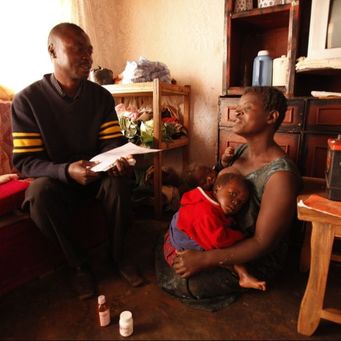CHW assists PMTCT patient with partner disclosure
|
Malawi has adopted the UNAIDS “90-90-90” goals, an ambitious treatment target to help end the AIDS epidemic aiming to achieve 90% of all people living with HIV know their HIV status, 90% of all people with diagnosed HIV infection receive antiretroviral therapy, and 90% of patients on antiretroviral therapy have viral suppression by 2020. Achievement of these goals, however, requires that patients accept their diagnoses and agree to take medication. Many do not realize the importance of taking and adhering to ART to prevent opportunistic infections and keep their bodies healthy, and if they do, psychosocial barriers in the home prevent them from accessing lifesaving ART.
In Malawi, some of the most significant barriers to accessing HIV care and treatment exist within the home. These barriers are particularly well known in PMTCT efforts. Women’s reluctance to disclose their status to their male partners is a key obstacle, impacting not only the health of the HIV infected woman, but the health of her exposed infant. |
Community health workers with the Baylor College of Medicine Children’s Foundation – Malawi (BCM-CFM) Tingathe Project addressing these challenges through provision of specialized case management and individualized approaches to counseling. The impact of this important CHW role is demonstrated in the story of Linda[1] and her family. Despite learning of her HIV status in 2015, Linda had evaded care. When she became pregnant, she was retested at ANC but continued to refuse life-saving ART. Despite multiple efforts during her pregnancy to trace her in the community, she was unreachable.
During a visit to the Under 5 clinic one day when her child had reached 6 months old, Linda received screening by Samuel[2], a Tingathe CHW. Under 5 screening is an important component of case finding at the Tingathe supported sites, and allows the clinics to reach families like Linda’s, who need to be reconnected to critical PMTCT services. Recognizing Linda as a client who continually refused ART services, Samuel and team determined that she should receive enhanced, targeted counseling, to which she agreed.
Through counseling and relationship building, Samuel was able to determine that Linda was avoiding care because she was terrified of disclosing her status to her husband, fearing violence and rejection. She had followed the general advice given – to ask him to come with her for testing – but he had refused and she could not disclose on her own. With reassurance and support, Samuel ultimately received permission from Linda to approach her husband and meet with him in his comfort zone – his house. Using his counseling skills developed as a CHWs, Samuel and his team were able to convince Linda’s husband to come to the clinic for counseling.
Linda, her husband, and their baby were all seen at the clinic the following day. The parents, who both tested positive, agreed to initiated ART, having gained an understanding of the value of ART from the CHWs. In follow up appointments, the couple has been seen to be supportive of each other in their treatment, and working as a team to keep their baby HIV free. Antibody results for the baby are thus far negative at 9 months. The CHWs who have built a relationship with this family will continue to support them through the PMTCT period.
[1] & [2] Name changed for confidentiality
During a visit to the Under 5 clinic one day when her child had reached 6 months old, Linda received screening by Samuel[2], a Tingathe CHW. Under 5 screening is an important component of case finding at the Tingathe supported sites, and allows the clinics to reach families like Linda’s, who need to be reconnected to critical PMTCT services. Recognizing Linda as a client who continually refused ART services, Samuel and team determined that she should receive enhanced, targeted counseling, to which she agreed.
Through counseling and relationship building, Samuel was able to determine that Linda was avoiding care because she was terrified of disclosing her status to her husband, fearing violence and rejection. She had followed the general advice given – to ask him to come with her for testing – but he had refused and she could not disclose on her own. With reassurance and support, Samuel ultimately received permission from Linda to approach her husband and meet with him in his comfort zone – his house. Using his counseling skills developed as a CHWs, Samuel and his team were able to convince Linda’s husband to come to the clinic for counseling.
Linda, her husband, and their baby were all seen at the clinic the following day. The parents, who both tested positive, agreed to initiated ART, having gained an understanding of the value of ART from the CHWs. In follow up appointments, the couple has been seen to be supportive of each other in their treatment, and working as a team to keep their baby HIV free. Antibody results for the baby are thus far negative at 9 months. The CHWs who have built a relationship with this family will continue to support them through the PMTCT period.
[1] & [2] Name changed for confidentiality

